My first encounter with the Adirondack Guideboat Company (AGB) was at an art fair during a summer visit to Vermont. Coming from the Midwest, I’d never seen or heard of a guideboat; their cedar 15-footer was the most beautiful boat I’d ever seen. My wife and I bought one of AGB’s navy-blue Kelvar guideboats as a “retirement present” and for 12 years I rowed it on lakes and streams and rivers throughout the Indiana countryside.
We moved to Vermont, and as time passed and the AGB catalogs kept appearing, I was drawn to the company’s newest boat in their line of rowing craft, the Vermont Dory, a 14′ flat-bottomed double-ender. One day, giving in to longing rather than need, I drove to AGB’s North Ferrisburgh shop to check it out. In their lobby sat a magnificent Vermont Dory, with spruce-green sides, cherry gunwales and decks, woven rush seats, and furniture-quality 7′ cherry oars with wonderful grain-swirls in the blade ends. I bought it on the spot and rowed it that day. When I pole-pushed off from the shore, the Vermont Dory softly drifted into a lengthy glide while I slid the brass oar pins into the oarlocks. Then, with the first reach-and-pull on the oars, the Vermont Dory went out into the river quickly, quietly, effortlessly, and straight. I blissfully made a nearly two-hour maiden voyage.
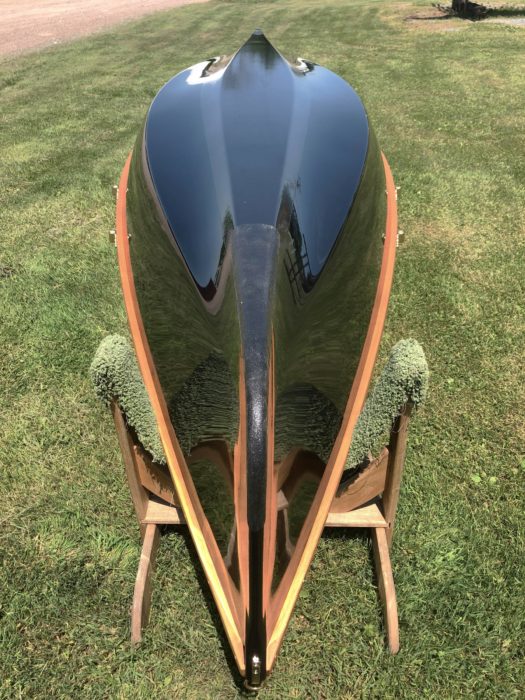 Photographs courtesy of Adirondacks Guideboats
Photographs courtesy of Adirondacks GuideboatsThe Vermont Dory is a 14′ double-ender based on Adirondack guideboats dating to the 1800s. The bottom of the hull has a flat to keep it upright when beached. The wide, low chines contribute to the boat’s reassuring stability.
The Vermont Dory was first developed by AGB in 2004 to build upon the abilities of the original guideboats that had been in use in the Northeast since the 1800s. As the “pickup trucks of the Adirondacks,” they were used for hunting, fishing, and hauling in areas where there were no roads. They were light enough to drag or portage overland, stable on lakes subject to heavy winds and waves, agile in rivers and streams, and capable of carrying two people and a week’s worth of gear. The Vermont Dory was recently modified with a wider beam (44″) and a broader flat bottom (30″) to be more stable, and to have more carrying capacity—up to 700 lbs.
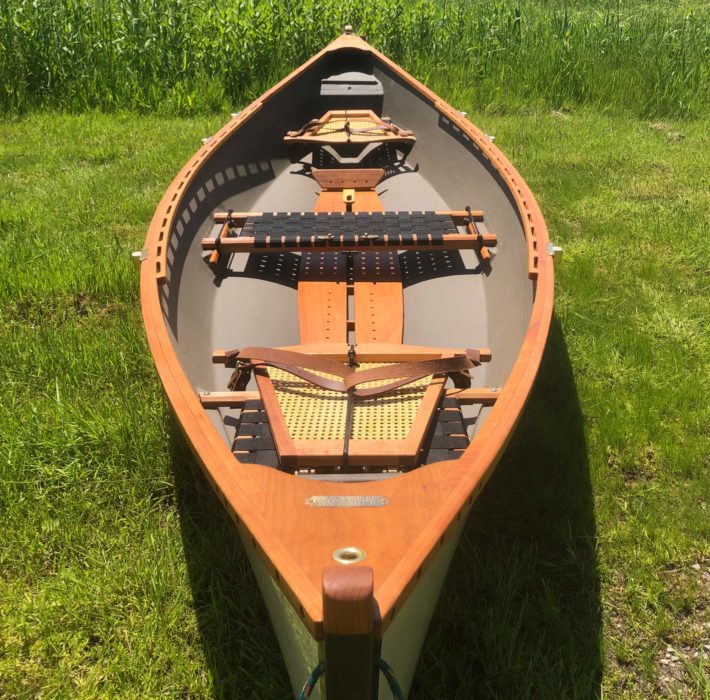
The seat backs are hinged and can fold forward or back. Leather straps keep them in a comfortable position when in use.
Each boat built at AGB is a one-off undertaking, hand-crafted by brothers Ian and Justin Martin, who together have over 35 years in the boatbuilding trade. The Kevlar hulls are reinforced with select cherry gunwales, with ends capped by a cherry deck. At each end is a flotation compartment, so the boats won’t sink if swamped. The frames for the seats are shaped from cherry, and the backs are made of a pre-woven material simulating old cane seats. The hull bottom and ends are reinforced with functional heavy-duty abrasion-resistant Kevlar skid plates; I know from experience that sand, gravel, or oyster bars won’t cut it.
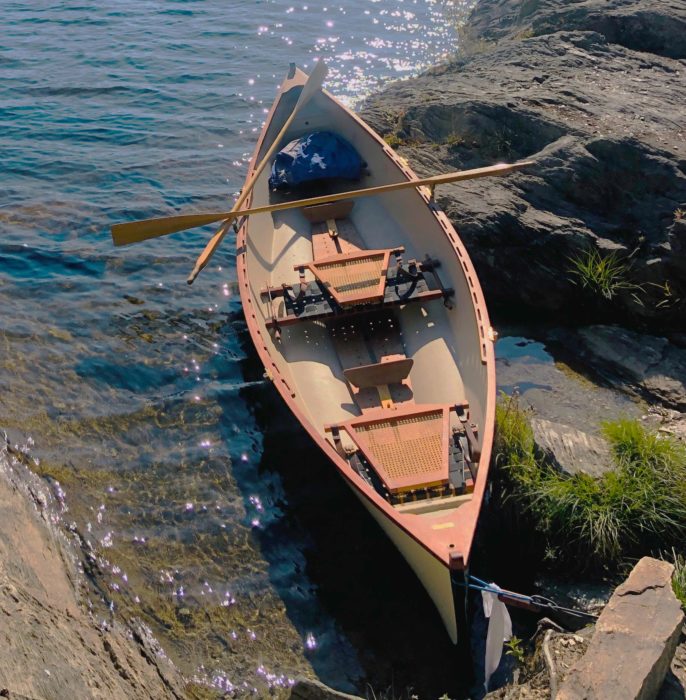
Although there is just one pair of oars shown here, two foot braces are secured to the floorboards for tandem rowing.
The oarlocks are the type originally used on Adirondack guideboats, with pins through the loom of the oar. The pins hold the blades vertically, preventing feathering, and keep the oars secure if the rower needs to let go of the handles quickly. There are three rowing stations: one in the center for a single rower and one at either end for rowing tandem or with a single passenger. (The rower can sit at either end of the Vermont Dory, with the passenger at the opposite end, and the rower’s end becomes the bow.) With the Vermont Dory’s high carrying capacity, a person can row from the center station with passengers in each end. Passengers are accommodated in cherry seats that can be moved forward or aft, for comfort, trim, or both. The seats are comfortable for long-distance rowing, or just sitting and having lunch on the water. All of the seats have backrests supported by leather straps with brass buckles so seats can be adjusted to a comfortable angle or lowered out of the way for a full range of motion while rowing or fishing. Adjustable foot braces lock into holes in the two floorboards and the slot between them. A sliding seat is also available. The seats are set low in the boat and provide a feeling of being close to the water while adding to the hull’s stability in heavy weather.
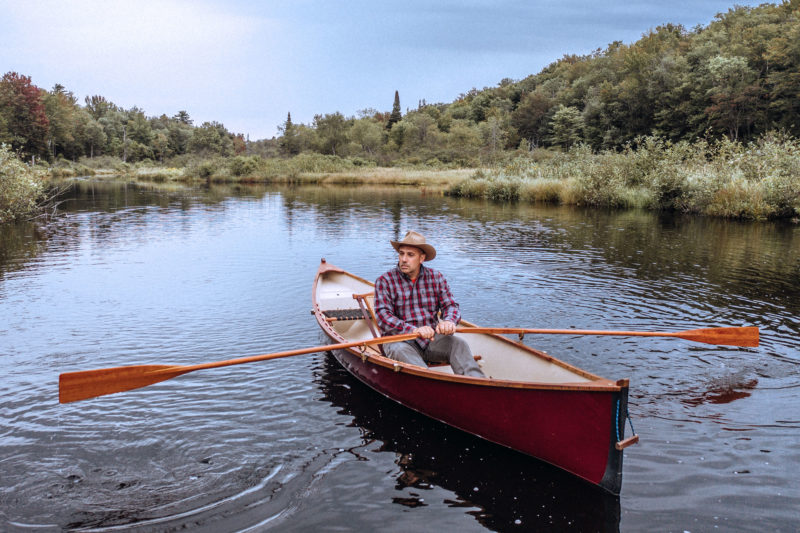 Nicola Visuals
Nicola VisualsThe pinned oarlocks hold the oars with the blades fixed in a vertical orientation, the typical arrangement for guideboats.
Initially I was worried that the wider beam of the Vermont Dory, compared to the classic guideboat, would prevent me from easily loading it into my SUV, transporting it, and smartly launching it; it was important to me to be able to do this by myself, so I could go rowing without help. The put-in and take-out times turned out to be just as good as with the classic guideboat: around 3 minutes. I carry the Vermont Dory in the back of my SUV, which has a truck-bed extension that slides into the trailer-hitch receiver. AGB sells a small trailer, as well. The Vermont Dory could be cartopped with the appropriate roof-rack by someone strong to lift the boat alone—or by someone with a helper. Wooden handles on either end facilitate the loading of the boat into the car. I usually drag the Vermont Dory to the water from the car. For portages, I bought a collapsible aluminum dolly.

For carrying a single passenger, the rower takes a seat in one end and the passenger sits in the other. It doesn’t matter which end, the dory can accommodate this arrangement going either direction.
I noticed immediately that the flatter bottom and wider beam of the Vermont Dory boat provided better stability for my entry and exits, a benefit for 78-year-old knees. The Vermont Dory is meant for fly-fishing, among other things, and I’ve heard that it is stable enough on the water so a person can stand and cast; but I’m not steady enough to give that a try…yet. I’m content pulling in a 9-lb bass every so often while I’m seated!
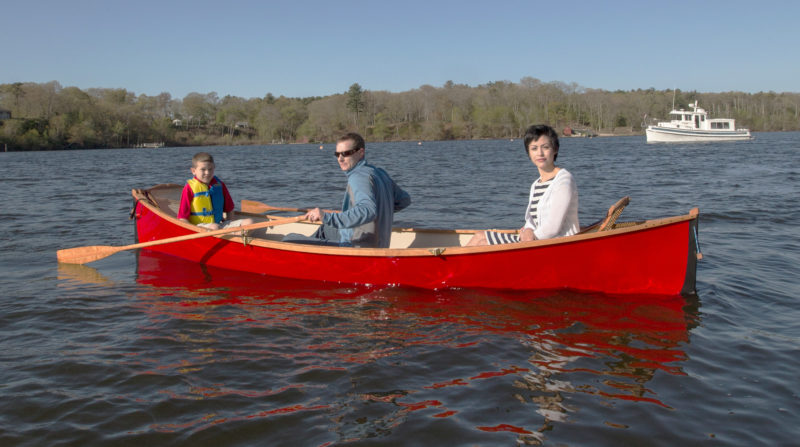
With seating for three, the Vermont Dory is well-suited to a young family.
As a camp-cruiser, fishing boat, or open-water recreational rowboat, the Vermont Dory is about performance: the rhythmic dip of the oars in the lake, the shush of the water passing the sides, and the satisfying feeling as the blades catch the water at just the right depth as the pull and glide begins.
The Vermont Dory cuts cleanly through curling white-topped waves without a hitch and rides up and over the big ones. The harder I rowed, the faster it goes, limited only by the power I can muster. But it’s so light that even at speed it will still stop, pronto, when you back-push the oars. The flat bottom makes it easy to spin the boat around by pulling on one oar and pushing with the other. Rowing in a crosswind took some getting used to, but I could soon adjust the balance of the pull on the oars to keep on course. It was much, much easier than managing a canoe. Rowing, surfing, and gliding downwind with the waves was the greatest fun, and the boat stayed well under control. When the wind blows and many canoes and kayaks stay beached, out I go, for the pure fun of it.
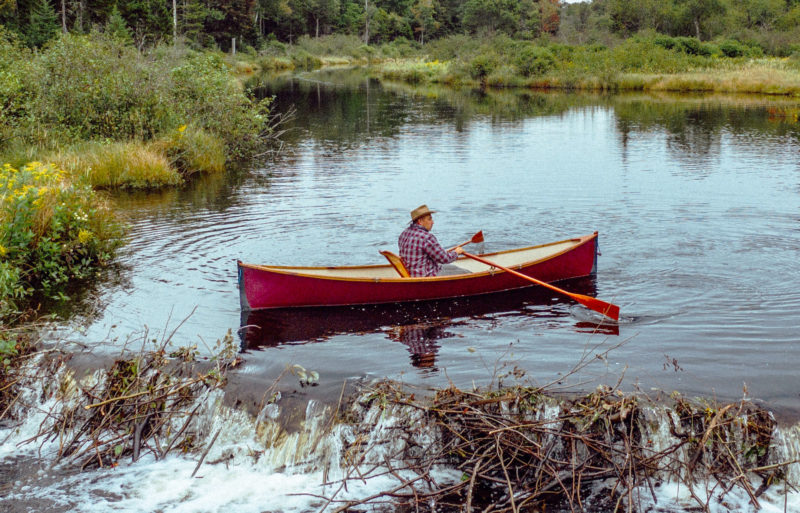 Nicola Visuals
Nicola VisualsWith its 700-lb capacity, the Vermont Dory can carry plenty of gear for wilderness adventures.
I’ve taken my Vermont Dory, BARBARA II, into the backwaters of the Indian River Lagoon in Florida, up through the tall weeds of Spruce Creek, along small boat trails in Canaveral National Seashore’s mangrove cuts, and on narrow runs on Snake Creek off the Saint John’s River. It draws only about 2″, making shallows and tides a non-issue. I use a long double-bladed kayak paddle as a backup for moving forward through tight places and brush, or when birdwatching. I also carry a 6′ push-pole I made, which is nice for launching and for navigating unexpected sandbars in the creeks.
My Vermont Dory boat, like my old guideboat from AGB, is well thought-out, well equipped, and well built. It is a very family-friendly boat, and I like to take people—especially my grandchildren—along with me, to experience the joys the Vermont Dory can provide whether rowing or coming along for the ride.
If you get one, plan extra time when you come back to your launch site after a row. Someone is always waiting with: “What is that beautiful boat? I’ve never seen a boat so smooth and so fast. Is all that hardware really brass? My gosh, look at the wood on the oars. Where did you get it?” And “Gee, could I give it a try?”![]()
Mike Schmidt lives a cloistered life in the small town of New Smyrna Beach, Florida, near the mouth of the Indian River where it opens into the Atlantic. He rows lagoons, mangrove backwaters, and streams with birds and dolphins for company. In the spring, he and his wife move to the hills of Vermont to live in an old log cabin, surrounded by forest and overlooking a small trout pond. He rows Lake Champlain, and its surrounding rivers and reservoirs and when not rowing, does sport shooting with a recurve bow and a shotgun, rides his bike, plays the guitar, works at playing golf, and, spends time with his grandkids.
Vermont Dory Particulars
[table]
LOA/14′
Beam/44″
Weight/80 lbs
Capacity/700 lbs
[/table]
The Vermont Dory is available from Adirondack Guideboats for $4,900. The price includes custom cherry oars as standard equipment.
Is there a boat you’d like to know more about? Have you built one that you think other Small Boats Magazine readers would enjoy? Please email us!

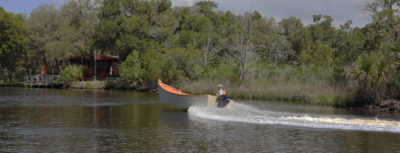
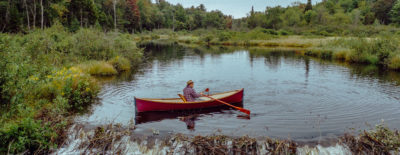
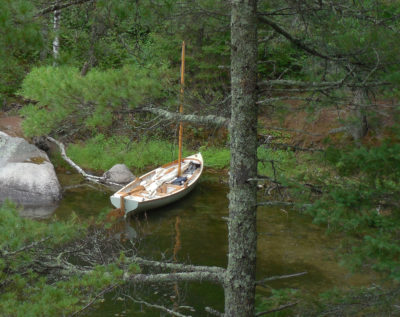
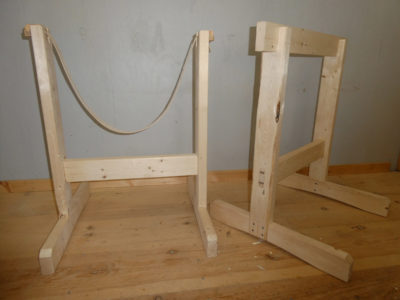
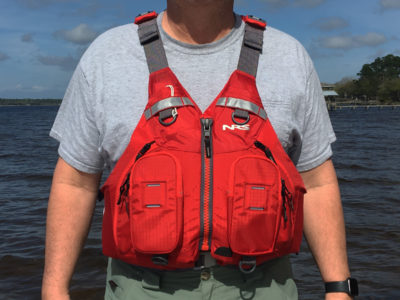
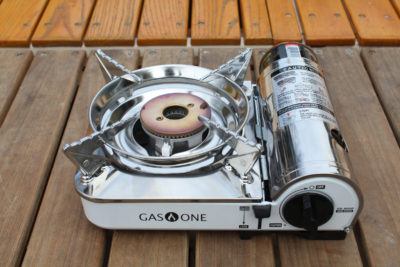
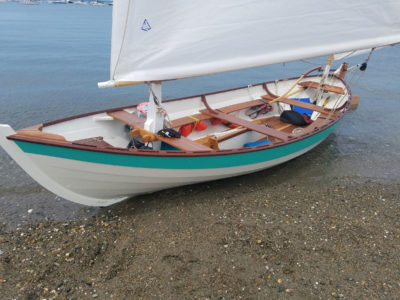
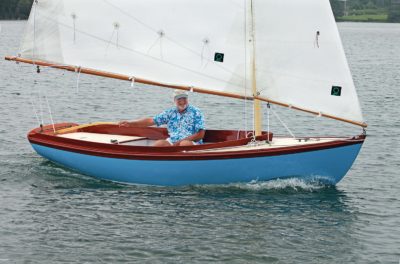
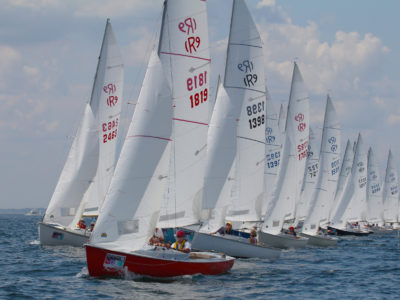

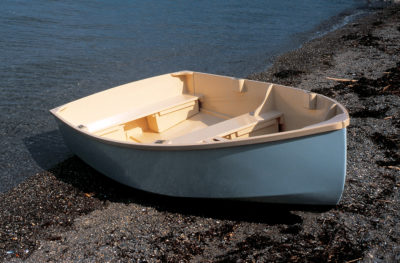
Can I get the plans for this boat or is it something I could build?
Evan B.
We offer a kit for the traditional Guide Boat but, unfortunately we don’t offer it in the 14′ Vermont Fishing Dory.
Very nice article. Great-looking boat. I particularly enjoyed hearing how the author has been using his dory.
Thanks for your comment! The Dory is our best selling boat and this article really gives a great explanation of our boat!
Thanks for sharing your Vermont Dory story, Mike. Three years ago, a move from upcountry Maine to Portland necessitated a pruning of a number of wood canvas canoes of all ages and a 17′ Rangeley guideboat double-ender, my long-time companion on many a camping and fishing trip on lakes in western Maine, particularly the chain of lakes bearing her name. In honor of that heritage, the Rangeley was donated to the Rangeley Region Outdoor Sporting Heritage Museum. Boatless for the first time in seven decades, I searched or a replacement of the Rangeley, but advancing years meant something lighter and more easily stored in the yard in Portland. Having rowed an AGB demo guideboat loaned by Steve Kulback at a summer event in Rockland, Maine, years ago, the joy derived in just fifteen minutes of running “anchorage slalom” lodged well in my memory cells, which led to a call to AGB the spring after the move to Portland. A spanking new red boat was on special sale, due to a slight color problem in the gel coat in one small place below the water line. A month later, Steve assisted Ian and Justin Martin by delivering it to our pond-side camp in western New Hampshire. A matter of love at first row, it, was promptly named MISS SCARLET, the vamp of CLUE. Since, then, she has been the perfect successor to my beloved Rangeley. Preferring to feather the spruce Shaw and Tenney 7’6″ oars that were included in the sale, I stitched leathers, and buttons to go with brass ring oarlocks rather than go with pinned looms. Other than the excellent layup, trim and all ’round beauty, her best sea-keeping feature is the configuration of her bottom, hence her name. The flat tapered shoe lying between concave sections and hard chines provide three bottoms in a way; one flat, two concave. The combination allows for easy speed, stability and excellent tracking for a keel-less boat weighing only 80 lbs. Her splayed dory sides keep her dry in a chop. On the pond or along the Casco Bay shore MISS SCARLET is the girl for me.
Love this! Ian and I are so glad you love your boat!
Wonderful. Thoughtful touches to a classic. 14 foot seems to be a sweet spot for friendly small boats that have great utility, and 80 pounds was a pleasant surprise. We restore a lot of boats and that weight is a good fit for our “wiser” customers, as well as families with kiddos. We also like the small business aspect of AGB.
You’re right, the 14’ Dory suits a lot of people’s needs, especially if stability is needed because of bad knees or for your young kids.
Thanks for the nice words!
Beautiful boat!! I would like to see how the rowing foot rests attach to floor boards. I have completed a rowing tender and was needing something like that.
A picture would be most appreciated
Thanks
The foot brace is held down with pins on the underside of the front part of the foot brace and the back part is held down with a brass T-bolt.
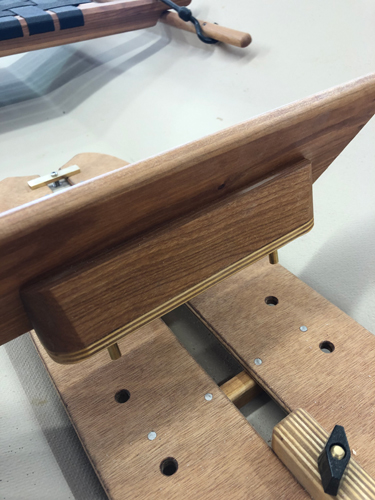
Sincerely,
Justin Martin
Adirondack Guide Boat
I bought the Vermont Dory 14 two years ago. I don‘t know how it rows because I only sail her here on Lake Constance. It is a excellent sailor, even with very little wind. I did a lot of modifying by the time. My latest adding is a small retractable e-motor (about 300 W). Great boat!
PS: Why not rowing it? Because I am so fond of my canoe with a Frontrower device.
As a small-boat sailor (I have a 15′ Delaware Ducker) and rower I would much appreciate info. On how you rigged her for sailing.
Thanks,
Alton Stone
I’m going on to my third season with my Vermont Dory and absolutely love it. It’s home is on a 1300-acre lake in near Nisswa, Minnesota. To me it feels like you are sitting in a sports car. One thing I like about it when rowing is that it holds a straight track very well and you are not wandering around, always making a correction on your course. There is a sliding-seat accessory you can put in place of the bench seat and using this gives me an increase of about one mile an hour of speed. I usually row a stroke rate of about 28 strokes per minute and this will give me an average speed of about 3.5 miles per hour.
Having built a couple of sailing rigs for our wood/canvas canoes, and having seen pictures of the one used on the Vermont Dory and in Todd Bradshaw’s book, Canoe Rig, the Essence and the Art, last spring I built a unified drop-in unit of cherry and a side-saddle clamp-on rudder with a push/pull tiller. I’ll use my canoe leeboards and a Dabbler Sails 50 sq. ft. lateen canoe rig. I think it will do the job. Has anyone out there used a lateen rig with a Vermont Dory?
It’s been a six-year love affair with my Vermont Dory. I’d never rowed before but wanted something that I could take my dog in and still explore bays and places like the MITA territory. I’ve always kayaked, but a dog in the cockpit limited me to calm waters. This craft has hit the sweet spot for me! Countless hours have been spent rowing it grinning ear-to-ear. As mentioned previously, be prepared for another eye-roll from your spouse, as another person stops to ask you about your beautiful boat!
So fine, so fine! A proper boat in every way. Life’s too short to not have a pretty boat. And a loving wife!